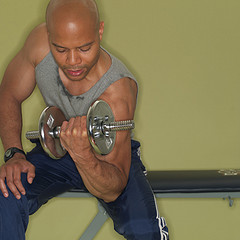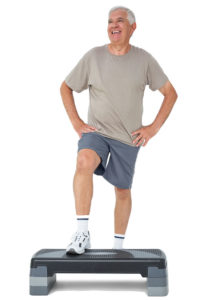Strength/Resistance
Raising the Bar
Asymmetrical bar training (ABT) can help clients enhance their sense of balance while improving their core strength and rotational power.
Physical Activity Type in Midlife Affects Mobility in Seniors
Studies have shown that seated desk work can have negative health and mobility repercussions as we age. A new study suggests that physically demanding jobs can also impact function later in life.
The study included 5,200 public sector employees participating in the Finnish Longitudinal Study on Municipal Employees. The primary purpose of the study was to understand the impact of leisure-time physical activity (LPA) and occupational physical activity (OPA) on mobility limitations among older adults.
Out-Muscle the Grim Reaper
Here’s more reason for older adults to pump iron: Researchers from the University of California, Los Angeles, have found a new link between lifting weights and longevity.
Is It Best to Lift Weights Before or After Cardio?
There’s a long-standing debate about whether order matters when combining cardiovascular exercise and strength training in a single session. Is it best, for example, to hit the treadmill before or after heading to the weight room? Researchers from the University of Jyväskylä, in Finland, believe they have the answer.
Home-Based Exercise Program Helps Hip Fracture Patients
Many older adults who break a hip contend with physical limitations even after rehabilitation. According to researchers led by Nancy K. Latham, PhD, PT, of Boston University in Massachusetts, a home-based exercise program may offer a way to reduce those limitations and improve strength and mobility.
Resistance Training Periodization in Women: New Insight for Training Design
Periodization offers a specific strategy for helping women get stronger with resistance training.
It has been well documented that appropriate resistance training can help people across a broad range of ages, fitness levels and health statuses. Resistance training improves muscular strength, muscular endurance and body composition while assisting the body to manage chronic ailments such as diabetes mellitus, obesity, hypertension, bone and joint diseases (osteoporosis and osteoarthritis), and depression (Warburton, Nicol & Bredin 2006).
Keeping Aerialists Flying Safely
Aerial, circus and acrobatic arts have recently seen an explosion of interest, thanks in part to the popularity of performance companies like Cirque du Soleil®. Combine this curiosity with the fun and variety that an aerial-based workout provides, and it’s easy to see what makes this an exciting fitness genre.
Aerobic Exercise and Strength Training for Older Women: Is There an Optimal Starting Dose?
We have good exercise guidance for fit older adults, but the advice for seniors just starting a fitness program has been less clear.
“What type of exercises/programs do you use with clients who have arthritis?”
The term arthritis describes two distinctly separate medical conditions: rheumatoid arthritis (RA) and osteoarthritis (OA). RA is an autoimmune disease that results in swollen, painful joints, which are a contraindication to exercise. If a client has this symptom, ask him or her to wait until it has diminished before exercising.
Circuit Training Helps Stroke Patients
According to a report from the British Medical Journal (2012; 344; doi: http://dx.doi.org/10.1136/bmj/e2672), 25%–74% of the world’s 50 million stroke survivors require assistance or are fully dependent on caregivers. To gain more physical independence, many seek help from physical therapists. That same report suggests circuit training can be a successful alternative to physical therapy.
“How much do you coach or emphasize breathing during a client’s workout? What do you do?”
I encourage my clients to breathe when they are working out, as in life. Jokingly, I say, “Breathing is the first thing you learned in life, so please do not forget to do it over the next hour that we are exercising.”
Functional Strategies for Older Adults
Exercise for older adults is one of the hottest specialties in fitness today. How do you assess function levels and develop safe, challenging programs? We asked instructors to tell us about their strategies for senior clients.
Suspension Exercise for Older Adults
Suspension exercise (SE) is a popular way to get fit for many people, and it’s no secret as to why. This method of exercise, where an apparatus attached to a single overhead anchor point supports the hands or feet, offers numerous benefits. Due to its popularity and the results people see from performing SE, programming has evolved to a point where fitness professionals are introducing it to their older-adult clients in the 65–80 and older age range.
Addressing the Fear of Falling in Seniors
With the Baby Boomer population aging, movement professionals have to become more prepared to meet the needs of older adults. And while it may be tempting to think seniors need less when it comes to program development, clients of advanced age actually need more.
It’s not enough to modify the intensity or safety of their fitness programs. It’s also essential to understand how the mindset that older clients bring to a session—in this case a fear of falling—can influence their exercise needs.
Resistance Training or Aerobic Training: Which Is Best for Weight/Fat Loss?
That’s precisely the question that researchers from North Carolina wanted to investigate.
Sample Class: Push, Pull, Bend, Twist, Squat and Lunge (BTSL)
During the past decade, the term functional training has been used to describe programs that mirror everyday activities. Functional exercises are sometimes referred to as multiplanar movements that require coordination of two or more limbs, muscle groups, joints or areas of the body. There is another simpler way to define functional movement: pushing, pulling, bending, twisting, squatting and lunging! Look closely at these gross motor patterns that humans perform daily and you see an easy formula and library of movement patterns for a strength training class.
Muscularity in Young Men Linked to Mortality Rates
That 98-pound weakling may want to hit the gym if he hopes to live a long life. A study published in the British Medical Journal (2012; 345: e7279) suggests that male adolescents without much muscle strength may earn early death in adulthood.
The large study included 1,142,599 Swedish males aged 16–19 who were followed for 24 years. The primary focus was to determine whether muscular strength had any impact on mortality rates. Premature death in this study was considered death before 55.
Lift Weights, Avoid Metabolic Syndrome
Weight training has many benefits. Warding off metabolic syndrome may be one of them, suggests a recent study.
Part of the National Health and Nutrition Examination Survey, the study set out to determine (1) how many adults lift weights regularly and (2) the impact of weight training on the prevalence and risk of metabolic syndrome. The findings, reported in the Journal of Strength & Conditioning Research (2012; 26 [11], 3113–17), included data on 5,618 adults aged 20 and older from 1999–2004. Here are some takeaways:
Strength Training Reduces Type 2 Diabetes Risk
Here’s another great benefit to including strength training in your clients’ fitness programs. A study in the Archives of Internal Medicine (doi: 10.1001/archinternmed.2012.3138) has reported that men who regularly lift weights may reduce their risk of developing type 2 diabetes.
Whole-Body Strength Training Using Myofascial Lines
Fascia has been enjoying the limelight in the fitness industry as one of the hottest topics in recent conference programming, workshops and publications. However, after the dust has settled, will…
















